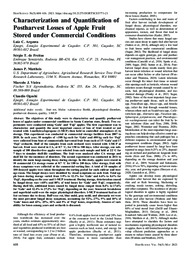Characterization and quantification of postharvest losses of apple fruit stored under commercial conditions.
Characterization and quantification of postharvest losses of apple fruit stored under commercial conditions.
Autoria: ARGENTA, L. C.; FREITAS, S. T. de; MATTHEIS, J. P.; VIEIRA, M. J.; OGOSHI, C.
Resumo: The objectives of this study were to characterize and quantify postharvest losses of apples under commercial conditions in Santa Catarina state, Brazil. Two experiments were conducted using ?Gala? and ?Fuji? apples. The first experiment was to characterize and quantify the most important causes of loss of fruit treated or not treated with 1-methylcyclopropene (1-MCP) then held in controlled atmosphere (CA) storage. This experiment was conducted in commercial storage facilities from 2007 to 2010. In each year, 10 samples of ≈380 kg each for ?Gala? and 400 kg each for ?Fuji? were collected from bins of commercially harvested fruit from each of 15 ?Gala? and 17 ?Fuji? orchards. Half of the samples from each orchard were treated with 1-MCP at harvest. Fruit were stored in CA, at 0.7 °C, for 150 to 300 days. After storage, one subsample of 100 disorder-free apples were selected from each sample and held at 22 °C for 7 days to simulate shelf-life conditions. The fruit were analyzed after CA storage and shelf life for the incidence of disorders. The second experiment was conducted in 2011 to identify the main fungi causing decay during storage. In this study, apples were stored in 10 commercial CA storage rooms at 0.7 °C for 180 to 240 days. After storage, fruit with decay symptoms were collected at the commercial sorting line. A total of 10 samples of 100 decayed apples were taken throughout the sorting period for each cultivar and storage room. The fungal decays were identified by visual symptoms on each fruit. Total apple losses during storage varied from 3.9% to 12.1% for ?Gala? and 6.6% to 8.4% for ?Fuji?, depending on the year and 1-MCP treatment. During storage, deterioration caused by fungal decay was ≈60% and 80% of total losses for ?Gala? and ?Fuji?, respectively. During shelf life, additional losses caused by fungal decay ranged from 8.4% to 17.6% for ?Gala? and 12.4% to 27.2% for ?Fuji?, depending on the year. Senescent breakdown and superficial scald were the major physiological disorders. 1-MCP treatment had no effect on losses due to decay. Bull?s-eye rot, blue mold, gray mold, and alternaria rot were the most prevalent fungal decay symptoms, accounting for 52%, 27%, 9% and 10% of ?Gala? losses and 42%, 25%, 18% and 5% of ?Fuji? losses, respectively. Sources of variability for losses among years and orchards is discussed.
Ano de publicação: 2021
Tipo de publicação: Artigo de periódico
Unidade: Embrapa Semiárido
Observações
1 - Por padrão são exibidas publicações dos últimos 20 anos. Para encontrar publicações mais antigas, configure o filtro ano de publicação, colocando o ano a partir do qual você deseja encontrar publicações. O filtro está na coluna da esquerda na busca acima.
2 - Para ler algumas publicações da Embrapa (apenas as que estão em formato ePub), é necessário ter, no celular ou computador, um desses softwares gratuitos. Sistemas Android: Google Play Livros; IOS: iBooks; Windows e Linux: software Calibre.
Acesse outras publicações
Acesse a Base de Dados da Pesquisa Agropecuária (BDPA) para consultar o acervo completo das bibliotecas da Embrapa.

